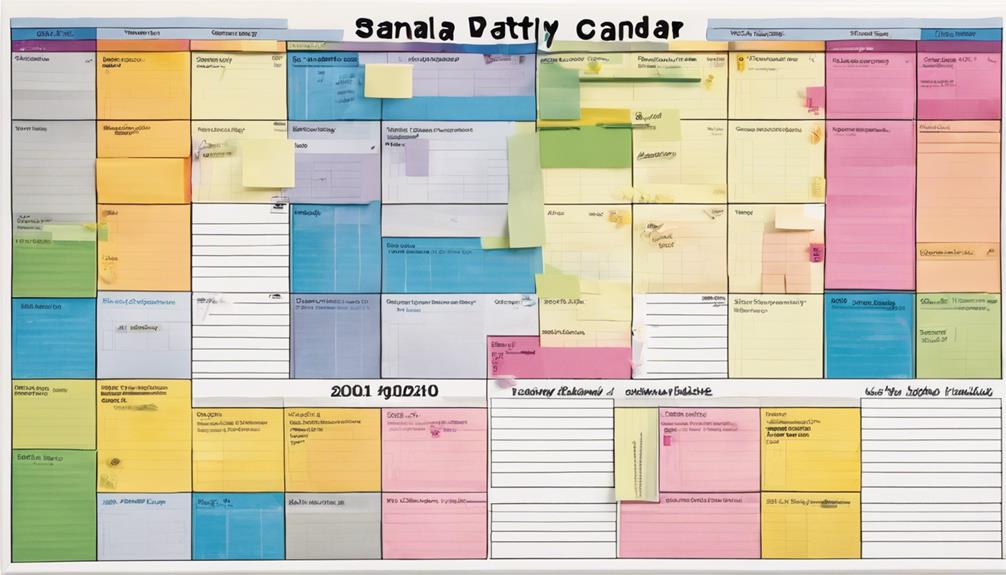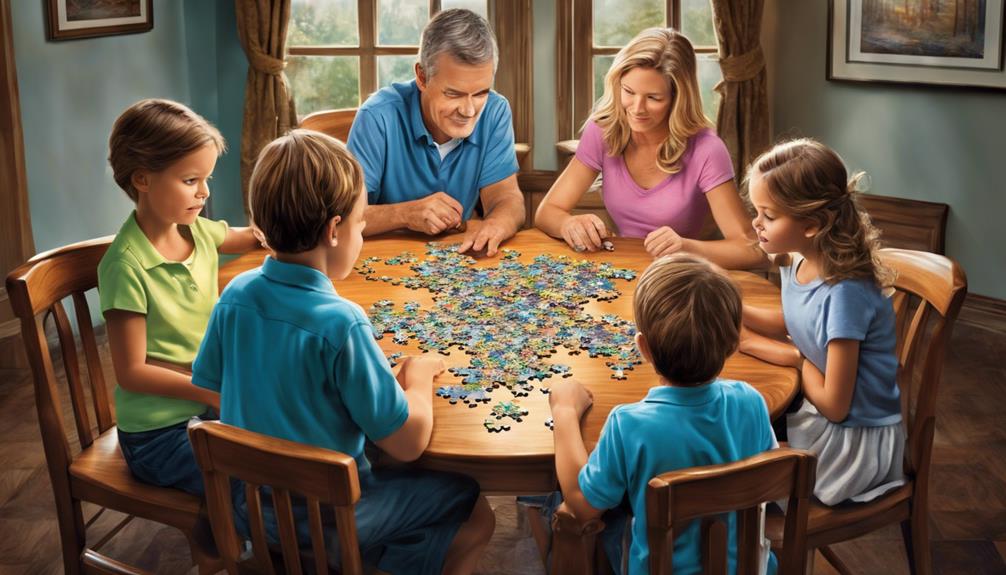When talking to children about divorce, it is important for both parents to be present to provide honesty and support. Select a comfortable setting and discuss the conversation together. Be honest, avoid placing blame, and acknowledge their feelings. Clearly explain future arrangements, involve them in the process, and provide information appropriate for their age. Assure them that the divorce is not their fault and emphasize love and support. Listen to their concerns and continue to offer care. Validate their emotions, explain the reasons for the divorce, and promote open communication. Make sure they understand that the decisions made are independent of them. For more tips on discussing divorce with children, prioritize honesty, support, and age-appropriate communication.
Key Takeaways
- Demonstrate unity between parents and provide a supportive environment.
- Maintain honesty and avoid blame to reassure the child it's not their fault.
- Clearly outline future living arrangements and involve children in decisions.
- Use simple language, address concerns, and match information to age levels.
- Reassure love, support, and emphasize ongoing care from both parents.
Approach the Conversation Together
When discussing the divorce with their children, parents should approach the conversation together to demonstrate unity and provide a supportive environment. This essential united front helps avoid conflicts and shows the children that both parents are there for them during this difficult time.
It's vital for both parents to be present during the discussion to offer support and reassurance to the children. By planning the conversation together, parents can anticipate questions, decide on responses, and effectively address sensitive topics that may arise. This preparation helps maintain consistency in the message delivered to the children about the divorce, reducing confusion and uncertainty.
Creating a supportive environment through unity allows children to better cope with the news of the divorce and helps them feel secure knowing that both parents are working together to guide them through this challenging period.
Choose a Safe Environment

To ensure a supportive and comforting atmosphere for children when discussing divorce, it's vital for parents to thoughtfully choose a familiar and secure setting. Select a location where the children feel comfortable, such as the family home, to break the news. Creating a safe environment allows children to freely express their emotions and reactions, fostering a sense of security during this difficult conversation.
Having both parents present during the discussion is essential to offer support and comfort to the children. Being in a familiar environment can help provide stability and reassurance, making it easier for children to process the news of divorce and adjust to the changes ahead. Ensuring a safe space for this conversation can help children feel more at ease and supported as they navigate the challenges that come with divorce.
Be Honest and Blame-Free

Choosing honesty and avoiding blame are key principles in effectively communicating with children about divorce. When discussing this sensitive topic, it's important to approach it with openness and fairness. Here are some significant points to keep in mind:
- Maintaining honesty: Building trust with children through honesty guarantees they've realistic expectations about the situation.
- Avoiding blame: Refraining from pointing fingers at the other parent helps children understand that divorce is a decision made by adults.
- Taking into account age and comprehension: Tailoring the conversation based on the child's age and understanding level is crucial for providing appropriate information.
- Steering clear of fault discussions: Keeping conversations focused on the facts and not on the faults of the other parent prevents children from feeling caught in the middle.
- Reassuring it's not the child's fault: Emphasizing to the child that the divorce isn't their fault alleviates any feelings of guilt or responsibility they may have.
Allow Emotional Expression

When discussing divorce with children, it's important to allow them to express their emotions openly. Encouraging kids to share feelings like sadness, anger, and confusion can help them process the news.
Providing reassurance and support while validating their emotions without judgment is key in creating a safe space for children to navigate their feelings.
Validate Their Feelings
Acknowledging children's emotions without judgment is crucial in validating their feelings during a divorce. When helping children cope with divorce, it's imperative to create a safe space for emotional expression. Here are five key ways to validate their feelings:
- Encourage open dialogue without criticism.
- Let them know it's normal to feel sad, angry, confused, or scared.
- Reassure them that their emotions are valid and understandable.
- Avoid downplaying or ignoring their feelings.
- Provide a supportive environment for them to share their emotions openly.
Encourage Open Communication
To create a supportive environment for children going through a divorce, it's important to foster open communication that allows for the free expression of emotions. Encouraging children to express their feelings openly and validating their emotions without judgment is crucial. Children should feel comfortable sharing a range of emotions like sadness, anger, confusion, and fear. It's essential to reassure them that what they are feeling is normal and acceptable. Avoid downplaying or ignoring their emotions; instead, provide a safe space where they can freely express themselves. Open communication and emotional expression play a significant role in helping children process their feelings and adapt to the changes effectively.
| Encouraging Open Communication | Benefits |
|---|---|
| Allows emotional expression | Helps processing feelings |
| Validates children's emotions | Creates a supportive environment |
| Normalizes a range of feelings | Facilitates adaptation to changes |
| Provides a safe space for expression | Promotes emotional well-being |
| Fosters understanding and communication | Supports children's mental health |
Provide Reassurance and Support
Encouraging children to openly express their emotions and validating their feelings without judgment is essential when providing reassurance and support during a divorce.
- Reassure children that it's okay to feel upset, angry, or sad about the divorce.
- Avoid dismissing or minimizing children's emotions, allowing them to process their feelings at their own pace.
- Listen actively to children's concerns and provide a supportive environment for them to share their thoughts.
- Let children know that their emotions are valid and that you're there to support them through this challenging time.
Inform About Future Arrangements

When discussing future arrangements with children about divorce, it's essential to clearly outline where they'll live and how visitation will be handled. Children need to understand the new living situations and how they'll spend time with each parent.
Providing age-appropriate information gradually can help them process the upcoming changes. Reassure children that they'll still have regular communication and visits with both parents to maintain their relationships.
If possible, involve children in the moving process so they feel included and informed about the changes happening in their lives. Emphasize to the children that both parents are working towards finding the best solutions for the family's well-being.
Involve Children in Decisions

Incorporating children's input in decision-making during divorce can enhance their sense of control and understanding amidst significant changes. When involving children in decisions:
- Empower them to feel valued and heard.
- Help them navigate overwhelming emotions more effectively.
- Foster a sense of control and understanding.
- Facilitate smoother changes post-divorce.
- Promote healthy communication between parents and children.
Allowing children to have a say in certain aspects of the divorce process, whether it's about choosing room decorations or visitation schedules, can make them feel like active participants rather than passive bystanders. By collaborating with children on decisions, parents can create an environment where children feel respected and acknowledged, ultimately leading to a more positive and cooperative family dynamic during and after the divorce.
Provide Age-Appropriate Information

When telling children about divorce, it's essential to provide information that matches their age and maturity level. Using simple language, addressing specific concerns, and reassuring them of love and support are key components in this process.
Use Simple Language
To convey the message of divorce to children effectively, tailor the language used to their age and level of understanding. Children comprehend information differently based on their developmental stage, so using simple and clear language is essential.
Here are some tips to help you communicate the concept of divorce to children in an age-appropriate manner:
- Use concrete explanations that they can relate to.
- Avoid using complex or confusing terms.
- Provide information about the changes they can expect.
- Be prepared to answer questions in a straightforward manner.
- Offer reassurance and support throughout the conversation.
Address Specific Concerns
Addressing specific concerns during the discussion of divorce with children involves providing age-appropriate information tailored to their understanding and needs. It's vital to take into account the child's age and maturity level when explaining details about the divorce. Using simple language and concrete explanations can help kids grasp the situation better.
Address worries they may have about where they'll live or how often they'll see each parent. Reassure them about future arrangements like visitation schedules or changes in living situations in a clear and understandable way. Offering support and encouraging open communication will assist children in processing their emotions and adjusting to the changes that come with divorce.
Reassure Love and Support
During the discussion of divorce with children, emphasizing love and support is crucial to helping them navigate the emotional challenges of this process.
- Offer consistent reassurance of love and care.
- Listen attentively to their feelings and concerns.
- Provide clear and age-appropriate explanations about the divorce.
- Guarantee both parents will continue to support and care for them.
- Tailor your approach to each child's level of understanding.
Reassure Children Its Not Their Fault

Reassuring children about divorce involves emphasizing that the separation is not their fault. It is essential to communicate to children that adult decisions are separate from their actions. Validating their feelings of guilt or responsibility can aid in helping them understand that they are not to blame for the divorce. Providing consistent reassurance that the divorce is due to adult issues can help alleviate their feelings of guilt. Encouraging open communication and addressing any misconceptions can reinforce the message that the divorce is not the child's fault. Assuring children that they are loved unconditionally despite the divorce can contribute to them feeling secure and supported.
| Ways to Reassure Children It's Not Their Fault | |
|---|---|
| Emphasize that adult decisions are separate | from their actions. |
| Validate feelings of guilt or responsibility | to help them understand. |
| Provide consistent reassurance about the reasons | for the divorce. |
Frequently Asked Questions
At What Age Is a Child Most Affected by Divorce?
Between the ages of 6 and 11, a child is often most affected by divorce. At this stage, they can comprehend complex emotions, potentially assigning blame and struggling with fear, anxiety, anger, or sadness. Reassurance and support are vital.
When Should You Tell Your Child About Divorce?
Parents should tell their child about divorce when both are ready, choosing a calm time for discussion. Waiting too long can lead to confusion. Being open and honest builds trust, reducing uncertainty and anxiety.
How Can I Help My Child Understand Divorce?
Helping a child understand divorce involves explaining in age-appropriate terms, reassuring them it's not their fault, providing a timeline of changes, encouraging questions, and expressing feelings. Avoid blame and unnecessary details while emphasizing love and support.
What Is Best for a Child of Divorced Parents?
Ensuring stability, consistent routines, open communication, emotional support, and involving children in decisions are best for a child of divorced parents. These actions help maintain their well-being, understanding, security, and involvement in the post-divorce process.
Conclusion
To sum up, when informing children about divorce, it's crucial for parents to approach the conversation together, select a secure environment, and be honest and free of blame.
As per the American Psychological Association, involving children in decisions and providing information suitable for their age can assist them in dealing better with the situation.
Remember to reassure children that they aren't to blame and allow them to freely express their emotions.
By following these steps, parents can help their children navigate this challenging time with understanding and support.










